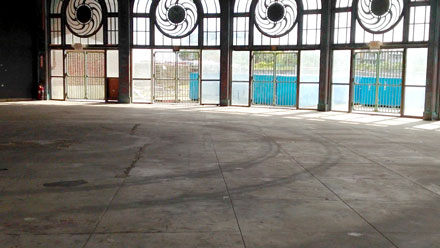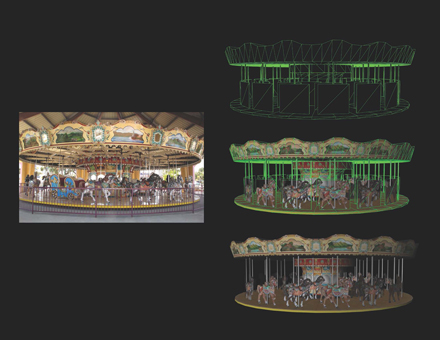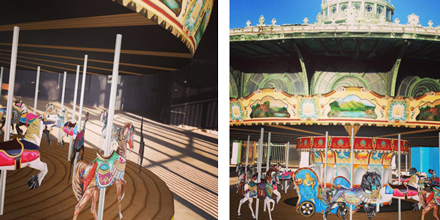Courtesy of the Asbury Park Public Library

Recent photograph of the Asbury Park Carousel House

Digital 3D model development of the Asbury Park boardwalk carousel

3D model development of an Asbury Park boardwalk carousel horse

Download the Project Booklet Here
We have a friend named James who owns and runs a novelty store on Cookman Avenue in Asbury Park. One of his favorite things to do as a child in Asbury was ride the boardwalk carousel. James and his siblings would ride over and over again and try to lean out and grab a ring that hung from a dispenser. Most of the rings were brass, but if you got a gold one, you got a free ride.
During one trip, the carousel operator let James and his siblings ride as long as they wanted — they were pretty woozy when they got off. When James speaks of the carousel, he shares very tactile and sensory memories of the carousel and the space, describing the smell of dust, popcorn, and cotton candy.
The Asbury Park boardwalk carousel is no longer there. In fact a lot of things that were once on the boardwalk are no longer there. And the carousel is only one of several major landmarks from the boardwalk that have either changed significantly, or are missing altogether.
How many times have you seen someone gesture at an empty space like a parking lot as a means to describe what was once there?
We listened to how important these places were to the collective memories of many visitors and the local community. And we thought to ourselves, "How can we help hold onto these memories?" We decided to explore using augmented reality technologies and started doing research on the whereabouts of the carousel.
We drove to Hatfield, Pennsylvania to visit the Philadelphia Toboggan Company, the original manufacturer of the carousel. We found out that this carousel was completed in 1930 and that it was the last carousel they built. In our further research, we discovered that the boardwalk carousel was moved from Asbury Park to its new home in Myrtle Beach South Carolina in 1990. It’s now in a small amusement park called “Family Kingdom”.
So, we drove to Myrtle Beach to shoot hundreds of photographs. We constructed and textured 3D models with the photos, and through augmented reality, we put a digital reconstruction of the boardwalk carousel back in the carousel house!
This Augmented Carousel project was exhibited at the World Maker Faire NYC 2013. It was well-received and earned an Editor's Choice Award. Following that success, we launched an ambitious Kickstarter entitled Augmented Asbury Park. To promote the project, we pushed on social media campaigns, contacted everyone we knew, and even dressed up as zombies for the Asbury Park Zombie Walk. (We helped break the world record for “largest gathering of zombies”!) And with not much time to spare, we received Kickstarter funding!
For the Augmented Asbury Park project, two specific locales have been important to us. The northern end of the boardwalk at Convention Hall, and the southern end at the Casino. These two epicenters are rich in history and memories.
In order to build these augmented experiences, we have worked with our own photographs as well as vintage postcards from archives and private collections. The Asbury Park Library collection has provided us images of major buildings and events such as the following:
- Palace Amusements, a structure that housed games, a funhouse, and the other famous Asbury Park carousel
- Morro Castle, a doomed passenger liner that caught fire off the coast and beached itself in Asbury Park
- Natatorium, an indoor saltwater swimming pool
- Monterey Hotel, a large luxury hotel that used to be just north of the still-standing Berkeley Hotel.
This project is a collaboration of Monmouth University professors Mike Richison and Marina Vujnovic and Kean University professor Ed Johnston.
Installation of the Augmented Carousel
geolocated in the Carousel House
BACK TO TOP
All rights reserved.
©






